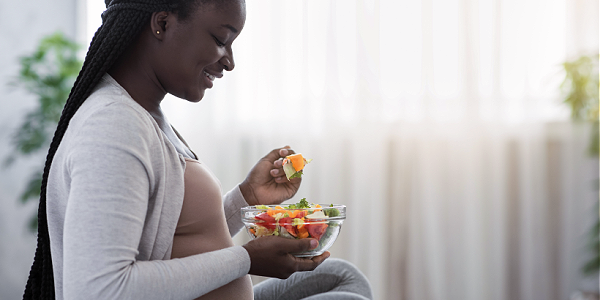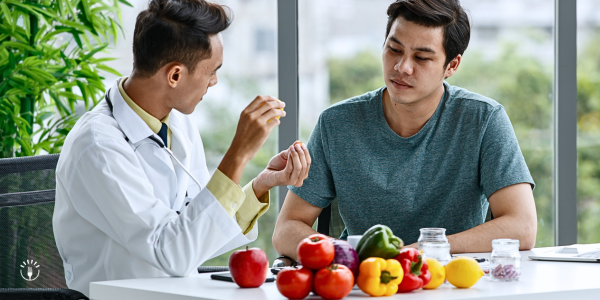
If you’ve had a history of gestational diabetes, it’s normal to be concerned about developing type 2 diabetes postpartum or later on in life.
But there’s good news!
You can take to reduce your risk of developing diabetes after pregnancy. Plus, preventing type 2 diabetes after gestational diabetes often involves the same strategies used to treat gestational diabetes, including healthy eating, exercising, and monitoring your blood sugar.
Continue reading to get answers to your questions about gestational diabetes after delivery, including “Does gestational diabetes go away?” Let’s get into it!
Understanding Gestational Diabetes
Gestational diabetes is a type of diabetes that occurs in pregnancy. Since pregnancy can affect the way the body processes insulin and blood sugar, pregnant women who haven’t been diagnosed with diabetes before pregnancy may be surprised to find out they have gestational diabetes after becoming pregnant. Gestational diabetes occurs in up to 10 percent of pregnancies per year in the United States.
As with normal diabetes, gestational diabetes happens because the body struggles to make enough insulin or utilize it effectively. Blood sugar balance is especially important during pregnancy, and unmanaged gestational diabetes may put you at risk for related complications and health problems, like high blood pressure. It may also put your baby at risk of being at a higher birthweight than normal, born prematurely, needing a Cesarean Section (C-section) to be delivered safely, or having blood sugar problems of their own.
Women usually find out if they have gestational diabetes between 24 to 28 weeks, during which time a glucose tolerance test is used to test for gestational diabetes. Although some cases may appear without warning signs, common risk factors of gestational diabetes include being overweight or inactive before pregnancy.
Some experts recommend testing blood sugar levels even earlier than the 24 to 28-week mark (such as in the first trimester, before 12 weeks) for clues on how your body manages blood sugar. A higher-than-normal result during early pregnancy may point to type 1 or type 2 diabetes, instead of gestational diabetes.
A high A1C, which indicates blood sugar balance over the past three months, in the first trimester may accurately predict cases of gestational diabetes. So, getting your blood sugar tested earlier rather than later may help inform you as to your level of risk for both gestational diabetes and type 2 diabetes.
Does Gestational Diabetes Go Away After Delivery?
Although gestational diabetes may sound intense and can certainly feel that way at times, it’s not all doom and gloom. Gestational diabetes goes away after the baby is born for many women.
However, about half of women diagnosed with gestational diabetes during pregnancy end up progressing to type 2 diabetes after pregnancy. This is thought to occur because gestational diabetes causes shifts in metabolism during pregnancy and combined with poor lifestyle habits (like lack of exercise or a poor diet), blood sugar issues may stick around after delivery and contribute to the development of type 2 diabetes.
Fortunately, preventative measures can be taken, whether you’re in early pregnancy or near the end of your 9-month journey. Knowing your level of risk often comes down to identifying fertility and pregnancy-related risk factors for type 2 diabetes, such as:
• Being unable to reach a healthy body weight after pregnancy
• Having a personal history of diabetes during pregnancy
• Having a baby weighing 9 pounds (or more)
• Having a history of hormone disorders (like PCOS)
As mentioned, gestational diabetes doesn’t guarantee you’ll develop type 2 diabetes. Like prediabetes, it can be a helpful “warning sign” that your body may be struggling to balance blood sugar. You don’t have to wait for your postpartum blood sugar checkup to start taking action to prevent type 2 diabetes.
If you’ve had gestational diabetes, you’ll likely be tested for diabetes a few weeks after your baby has been born (around 6–12 weeks postpartum). If your blood sugar is still elevated at this point, you may have type 2 diabetes. Rest assured that if this is the case, your doctor or healthcare team will guide you on the next steps and provide strategies for controlling blood sugar as a new mom.
How to Prevent Type 2 Diabetes After Gestational Diabetes
If you’re looking to manage gestational diabetes in a way that minimizes your risk for type 2 diabetes, here are some of the top tips. Typically, strategies to prevent type 2 diabetes are relatively similar whether you are pregnant or not (with a few important exceptions).
Eat Well
Aiming to have a balanced diet daily can help prevent problems for you and your baby. Following a visual pattern like MyPlate as you create a meal can ensure you get enough of each food group. Meeting with a women’s health dietitian or a Certified Diabetes Care and Education Specialist (CDCES) can help you better understand the benefits of certain foods and their unique effects on blood sugar.
If you’re having trouble maintaining a healthy diet, know that meal delivery is always an option. Pregnancy and postpartum place so many demands on the body and mind that it’s understandable that you’d want to take something off your plate! Consider trying a meal delivery plan that meets your nutritional needs during this unique phase of life, such as bistroMD’s Women’s Program.
Engage in Exercise
Just as exercise is a healthy habit during pregnancy, physical activity is good for you after pregnancy, too. Remember that you won’t need to get walking right after delivery. It’s important to wait until your doctor clears you for exercise, which will likely be around six weeks postpartum.
It’s important to ease back into being physically active, such as by striving to walk for 30 minutes most days of the week. Every step you take adds up and makes a difference in preventing diabetes. Don’t forget that chasing kiddos around counts for burning calories, too!
Understand Weight Management
One way that diabetes prevention differs during pregnancy is that it’s not typically recommended to lose weight while pregnant. If you’re hoping to be pregnant soon but not yet, getting to a healthy weight before pregnancy can help reduce your risk for both gestational and type 2 diabetes.
However, if you are currently pregnant, it’s unlikely that your healthcare team will recommend weight loss. For your baby's health, you’ll experience a gradual weight gain during pregnancy, and you can check with your doctor or OBGYN to ensure you’re not gaining too much (or too little).
After pregnancy, it’s important to remember you may not “bounce back” to your pre-pregnancy weight right away, even though it is essential to have the goal of returning to a healthy weight post-pregnancy. Many women find it takes 6 to 12 months after delivery to get back to a healthy weight, so be patient and kind to yourself. After all, you did grow a baby for nine months, so it may take that long (or longer) to achieve your weight loss goals.
Breastfeeding your baby may help you burn calories and lose a bit of post-pregnancy weight— not to mention it’s good for the baby, too! If you are unable to breastfeed, know that there are some excellent formula options available for your baby and that you are no less of a mom in any way.
Set Up a Support System
As mentioned above, pregnancy and postpartum are a demanding phase of life. You aren’t expected to do it alone, including type 2 diabetes prevention. Ask partners, family members, and other loved ones to assist you as you labor (pun intended) to keep yourself and your baby healthy. Hands-on help may be especially crucial following delivery.
You may wonder, “What does asking for help in preventing diabetes postpartum realistically look like for me?” It may include asking friends to bring meals or casseroles after delivery to focus on nourishing options to help balance your blood sugar. You can ask for “diabetes-friendly meals” to help communicate this to your support system. Asking for help can also include requesting a referral from your doctor when taking care of both you and your baby feels mentally exhausting.
In short, identify areas where you feel like things are “falling through the cracks,” so to speak, and allow those around you to help fill in the gaps. If you don’t live close to family, don’t be afraid or ashamed to hire help.
Monitoring Your Health Post-Gestational Diabetes
Ongoing tests and monitoring are important parts of preventing type 2 diabetes after gestational diabetes. Meeting regularly with your healthcare team not only provides you with medical guidance but also connects you to special tests and screenings that can assist you in identifying risk factors for diabetes.
If your blood sugar is normal postpartum, but you’ve had gestational diabetes in the past, it’s recommended to get screened for type 2 diabetes at least every three years. Testing for type 2 diabetes after gestational diabetes is similar to standard type 2 diabetes screening and will likely include a series of blood tests (like hemoglobin A1C and plasma glucose) and an oral glucose tolerance test (OGTT).
Between screenings, you can check your blood sugar regularly at the doctor’s appointments or use a device—such as a glucometer or continuous glucose monitor—recommended by your healthcare team. These devices aren’t always recommended for non-diabetics, but your doctor may prescribe them to help give you peace of mind or to feel more empowered and self-motivated on your journey to improve your health.
Preventing Type 2 Diabetes After Gestational Diabetes: Final Takeaways
Gestational diabetes seems like a scary diagnosis, especially when you take the increased risk for the baby and developing type 2 diabetes later on into account. Luckily, a few essential lifestyle habits (like diet and exercise) can help you both manage gestational diabetes and prevent type 2 diabetes postpartum.
In the demanding days of birthing and raising a baby, remember there’s no shame in asking for help as you strive to be healthy. Consult with your doctor or dietitian for personalized advice, and employ the assistance of friends, family, or even meal delivery when you need a moment to yourself.
You’ve got this, mama!






